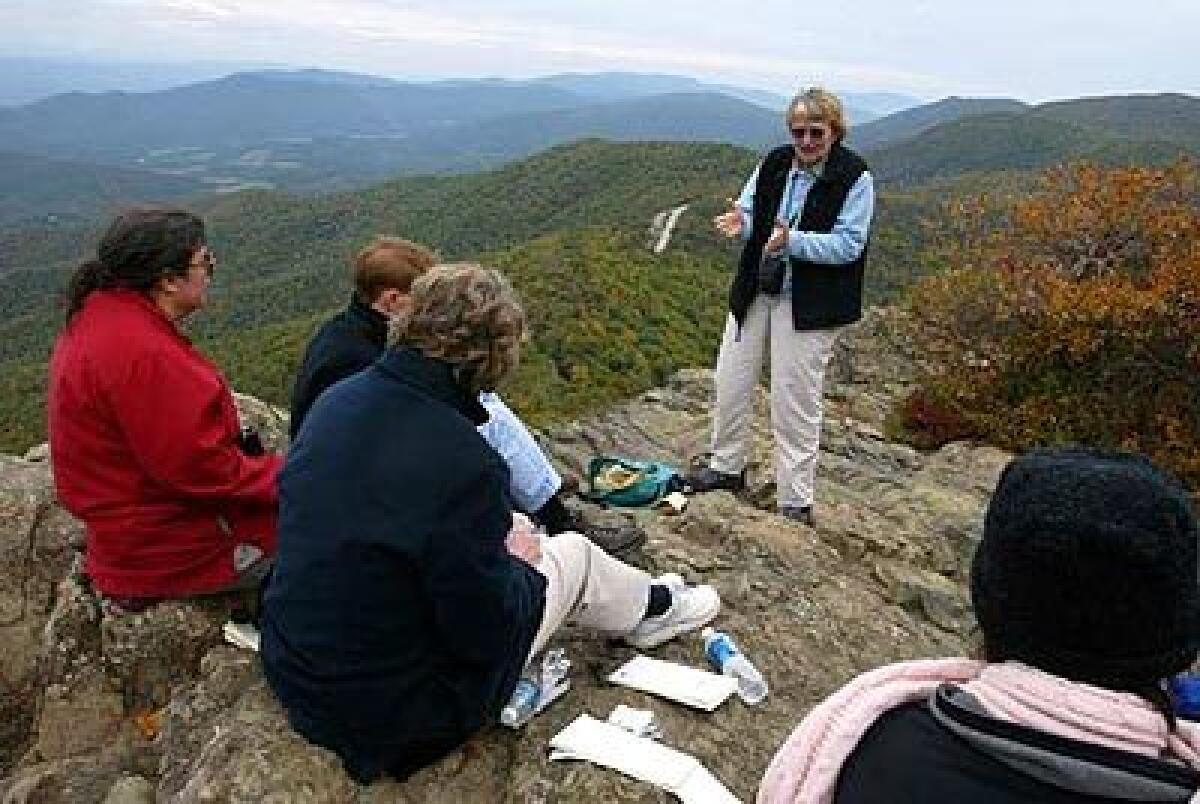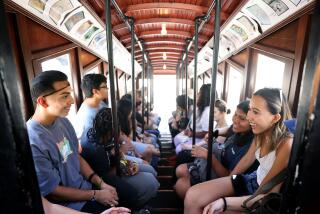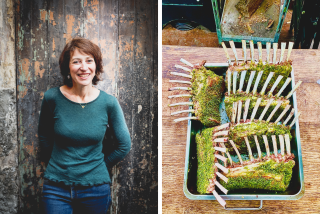Wrapped in an all-French weekend

Luray, Va. — Outside the picture window, the setting sun sends long shadows over violet, lavender and indigo peaks. Stars in the darkening sky seem to echo the tiny sparkles appearing in the valley far below. Edith Piaf trills in the background, and five new friends and I, speaking only French, make our way through a five-course meal in typical French style: with lots of talk and even more wine.
All the Gallic touches are here — Président brand butter and salt for the radishes, an endless supply of baguettes, three kinds of pâtés, three cheeses and espresso served in demitasse cups. If I didn’t know better, I could be somewhere in France, admiring the sunset over a romantic landscape. But I have driven only two hours from my Northern Virginia home and paid a fraction of the cost of a plane ticket to Paris.
Voilà, my first experience with a language-immersion weekend in the Blue Ridge Mountains of Virginia.
Last summer, I decided it was time to resuscitate my fast-failing French skills. A trip to France wasn’t practical, alas, so I thought a local class might do the trick. On the Alliance Française Web site I discovered a tiny ad for the French-American Exchange: “Learn French in France or Shenandoah Mountains,” it said.
The exchange sends most of its participants to France — Paris, Tours, Montpellier, Aix-en-Provence and Cannes — for programs that last two weeks to a year. All that sounds wonderful, of course, but for those of us who don’t have the time or the money, there’s the Blue Ridge weekend program.
Jim Pondolfino, an energetic, good-humored, fortyish Italian American who speaks French like a native, is the man behind the weekend program.
“Speaking a foreign language and traveling to foreign countries have always been passions of mine,” he says.
He studied French in school, then spent five years in Tours and Montpellier, where he learned the language inside out. He has 10 years of teaching experience and a knack for teaching kindly, a good trait when it comes to helping adults with rusty French skills dredge up long-lost vocabulary and grammar concepts. Pondolfino founded the exchange in 1987 and runs six Blue Ridge retreats a year.
There were four of us students on that weekend. Diane Dickinson, the mother of three adolescents, was searching for a productive and exciting way to spend the next chapter of her life. “Perhaps teaching French,” she said. Valerie Powell, an international lawyer who speaks German and Russian fluently, wished to refine her third foreign language. Jeff Levi needed a quick refresher course before a trip to Paris. And me.
We all were in the same boat: We knew French better at one point in our lives, and we wanted to know it again.
But the program is suitable for “anyone who can communicate on at least a basic level all the way to advanced,” Pondolfino says. Most students can hold at least a basic conversation on a variety of subjects.
Pondolfino loves to tell the story of a French teacher who couldn’t string together a sentence, but given Pondolfino’s adeptness, I’m sure even that poor educator got a lot out of the weekend.
Our base was a country chalet on the Luray side of the Blue Ridge, about 90 miles west of Washington, surrounded by trees and fields with cows and overlooking the storied Shenandoah Valley.
“No neighbors at all,” Pondolfino says enthusiastically.
It was a charming, privately owned three-bedroom cabin, typical of the Virginia countryside, with rustic wood trim and a screened porch. With a little imagination, you might well think you’re somewhere in the French hinterland. Certainly my room, with its brass bed and tiny-flowered wallpaper, felt more French than Virginian, non?
A monolingual marathon
The No. 1 rule that weekend was to speak French and only French. (Thank goodness I got to sleep some of the time.)Besides Pondolfino, we had another instructor, Kathy Chamberlain, a freelance translator and interpreter with the State Department. They were by our sides at all times, prompting us to speak, correcting us when we misspoke, encouraging us to speak and practice some more.
And if either heard a single English word, they interrupted: “Qu’est-ce que vous avez dit? En français!” (“What did you say? In French!”)
They helped us with sticky grammar issues and were always nice about it. Each day we had a formal grammar lesson at the chalet, aimed at errors that Pondolfino and Chamberlain had overheard. As much as anyone hates grammar, we all agreed the séances (sessions) were a helpful, fairly painless review of problematic issues.
For leisure, we hiked in Shenandoah National Park, speaking French all the while, of course. On Saturday we walked along a trail fringed with mountain laurel to Little Stony Man overlook, where we ate ham-and-cheese-filled baguettes on boulders high above the Shenandoah Valley. The meal ended with steaming cups of espresso brewed in the wild.
Sunday we strolled the longer Mathews Arm trail to Overall Run falls, where we picnicked in a glade. Both days we were assigned a partner, whom we had to interview along the trail and then introduce to everyone else over lunch. The first day was a simple, personal introduction. The second day the task was harder: We had to talk about what we would change in our lives if we could — using the conditional tense.
The pièce de résistance was the Saturday night meal. A menu had arrived with my confirmation in the mail several days before my departure, so I knew what to expect. I couldn’t wait. We students helped prepare the dinner, chopping onions, washing the lettuce for the salad. But Pondolfino did most of the work. And, in typical French manner, he made it look easy.
We began with amuse-bouches (appetizers): olives and radishes served with butter and salt, à la française, accompanied by a glass of sweet, refreshing white Picpoul de Pinet from the Côteaux du Languedoc. We moved to the candlelit table to enjoy the entrée: three types of pâté with cornichons, served with a 2000 Chardonnay from Domaine Trois Frères. The main course was served at sunset: delectably tender chicken breasts infused with white wine and mustard sauce, topped with mushrooms and onions and garnished with carrots and asparagus. Then came the salade verte (green salad) with mustard vinaigrette, followed by a plateau de fromages with three types of cheese, both enhanced with a Merlot-Cabernet Sauvignon from Château de la Tuilerie. And for dessert, a sinfully rich chocolate cake with espresso on the side.
Friendly conversation underlined the extravaganza — the effects of Sept. 11 on travel, how progress was (not) going on Jeff’s house renovation, whether Diane’s children would fare well without her for a weekend. It was like being at a good friend’s house. Tired and full, I glanced at my watch, surprised to find four hours had buzzed by.
It was an exhausting weekend — 36 straight hours of speaking French. My head ached for a week afterward, but it was a pleasurable way to refresh a language skill. Admittedly, at the weekend’s finale I wasn’t speaking like a native, but my French certainly got a good boost. Looking back, it was the details that made the experience.
“We bring France to Virginia,” Pondolfino said repeatedly throughout the weekend, and, indeed, French-American Exchange does, down to the French music, the French news broadcast on Sunday morning and the breakfast coffee served in café-au-lait bowls.
As much as I love to travel to France, I learned something else on this weekend. There’s no need to travel so far when a bit of France lies in my own backyard.
More to Read
Sign up for The Wild
We’ll help you find the best places to hike, bike and run, as well as the perfect silent spots for meditation and yoga.
You may occasionally receive promotional content from the Los Angeles Times.






